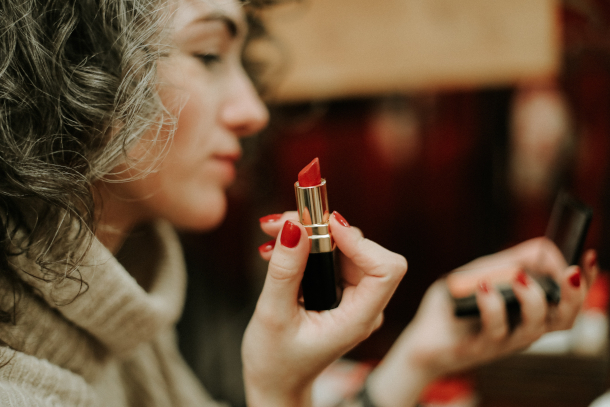Hormone Disrupting PFAS Chemicals in Makeup
Air Date: Week of July 16, 2021

PFAS chemicals help lend water resistance to mascara and other beauty products but have been linked with numerous health problems including infertility. (Photo: Carlos Martinez on Unsplash)
A recent study found PFAS “forever chemicals” dangerous to human health in many beauty products tested, with long-lasting and waterproof lipsticks and mascaras containing some of the highest levels. Ami Zota, a professor of environmental and occupational health at George Washington University, joins Host Steve Curwood to discuss PFAS health risks, environmental justice and more.
Transcript
[MUSIC: The Temptations “Beauty Is Only Skin Deep” Single, Motown Records]
CURWOOD: Sure, beauty may only be skin deep but new research finds that numerous cosmetics contain PFAS “forever chemicals” that can travel deep inside our bodies and linger. Long-lasting lipstick and mascara may be applied for only a day, but the PFAS they contain may boost the lifetime risk of cancer and infertility. And researchers at the University of Notre Dame have also found PFAS in other makeup including foundations, concealers, and eyeshadow. Ami Zota is a professor of environmental and occupational health at George Washington University. She was not directly involved in the Notre Dame study but joins us now from Washington DC to give us some insights. Welcome to Living on Earth, professor!
ZOTA: Thank you for having me. I'm a big fan of the show so it's an honor to be a guest.
CURWOOD: So what are the health impacts that have been linked to these chemicals?
ZOTA: Yes, this is an active area of research. For example, my lab is currently doing research on the effects of PFAS in pregnant women, so on pregnancy complications, as well as cardiovascular disease risk later in life. So a very active area of research. What we do know from a combination of both experimental animal studies, as well as epidemiologic studies, so those are ones conducted in humans over many years, that PFAS can affect many different systems in our bodies.
CURWOOD: What kind of health effects are you talking about?
ZOTA: So in newborns and young children, which is one particularly vulnerable group, we see lower birth weight, delayed mammary gland development, and even reduced response to vaccines. In adults, there is a consistency in the data with respect to thyroid disease, increased cholesterol levels, liver damage, kidney cancer and testicular cancer. But you know, the science is not able to catch up to how quickly new chemicals are being produced. So really, we've only kind of really studied well, a handful, maybe like five to seven PFAS. And here we have, you know, four to 8000 of them circulating in the environment.

Lipsticks, especially ones advertised as long-lasting, can contain high levels of PFAS, the study found. PFAS chemicals are known to interfere with hormone systems. (Photo: Daria Gordova on Unsplash)
CURWOOD: So this recent study from the University of Notre Dame found PFAS chemicals in more than half of 231 cosmetics they tested. How did they actually test how much PFAS is in these products?
ZOTA: Sure, they used a two-prong approach, which I thought was smart in terms of just getting a lot of information and trying to do it in a cost-effective manner. So first, they screened over 200 products for fluorine count. So they were looking at the total fluorine in chemicals. And so they were kind of leveraging the fact that the fluorine compound is central to all PFAS. And they were really looking for that fluorine detection. And then what they did was they took 29 products that had total high fluorine concentrations, and they used kind of more precise methods that are well accepted in the analytical chemistry space to measure more precise concentrations of a range of PFAS in those 29 products.
CURWOOD: Now, I have to confess something here. I don't do much in the way of television anymore, but I used to do a lot of television. And in that game, there's a lot of makeup, they would put a foundation on me, they would put something to cover up my various spots. They even put stuff around my eyes. I didn't get much in the way of lipstick. 'Course now I do radio I don't do so much in the way of cosmetics. But there are a lot of people in this country who are putting this stuff on their faces every day, largely women, right? What is the public health risk, do you think, to this stuff?

Research shows that for many people the main source of exposure to PFAS “forever chemicals” is drinking water. (Photo: LuAnn Hunt on Unsplash)
ZOTA: Those are good questions. So my research has examined the impact of other chemicals in cosmetics, like phthalates and parabens, on health effects. And we do know that those exposures can be substantial, because we're talking about chronic everyday use, right? And it's often these chemicals are sitting on your face for hours, they can be absorbed. We know from human studies that still for the majority of people, the main kind of route of exposure to PFAS is drinking water and diet. Our studies that use survey information and other, you know, drinking water concentrations and other methods have mostly shown that the communities with the highest exposures, it's often because they have contaminated drinking water sources. But I think that this study opens the door and the need to really examine the role of cosmetic use in PFAS risk, especially certain vulnerable populations.
CURWOOD: Ami, to what extent is this an environmental justice issue?
ZOTA: Many people wear cosmetics, right? But women of color, often, well they spend more on cosmetics, and they tend to use more toxic cosmetics. If you think about the workplace, women of color are often minorities, especially in professional workplaces. And so there are a lot of norms about how they have to appear. There's a lot of workplaces, corporate workplaces and even the military until a few years ago, that didn't allow black women to wear their hair naturally. And I think for many women, there is a pressure to show up with your hair very well done, and with a face with a lot of makeup. So my group has spent a lot of time kind of reframing the problem of chemicals in cosmetics through an environmental justice lens. And we do that because we want to highlight the role of racism and colorism, you know, the powerful role these systems of oppression have in shaping beauty norms, and everyday beauty practices.

Professor Zota encourages re-examining the narrow, colorist beauty standards that require women of color to use toxic chemicals to straighten their hair or put on a full face in order to fit in at the workplace. (Photo: Etty Fidele on Unsplash)
CURWOOD: Now, PFAS chemicals are used, in part because they can make these beauty products last longer and more water resistant. But what are some alternatives for people who are concerned about this? What are some products that have little or no PFAS, that nonetheless are long lasting and can get somebody through the day?
ZOTA: I don't think the answer will be the same for everybody. I think that many of the safer alternatives are more expensive. And so that really points to access and unequal access, and a lot of the safer products not being accessible to lower income communities, often communities of color. There are some resources, like the Environmental Working Group Skin Deep, the Detox Me app by Silent Spring Institute. And Clearya also has a database that is gaining more traction, that does provide some useful information. But you know, there are some shortcomings as well, right? Because EWG develops their ratings based on what's in the ingredients. But what we learned from this study is that in the majority of the cases, the products with high PFAS didn't necessarily have PFAS listed on the label. These databases are only going to be as good as the information we have, right? And so sometimes it's about maybe not getting the long lasting lipstick, or the 24 hour, the 12 hour mascara. Maybe, you know, maybe that's you know, a possibility. There's also safer silicones that can be used in certain products like foundations. But ultimately, individual actions will only take us so far, we need more systems wide interventions to this problem.

Ami Zota is an Associate Professor in the Department of Environmental & Occupational Health at the George Washington University Milken School of Public Health. (Photo: Courtesy of Ami Zota)
CURWOOD: Professor, from your perspective, what kind of policies do you think are needed now to protect people from exposure to PFAS chemicals?
ZOTA: So there is a bill right now, to ban PFAS from cosmetics. I think that's a good step in the right direction. This bill would ban the entire class of PFAS, especially focusing on limiting the intentional use of PFAS in cosmetics. But it's also important that Congress give FDA greater authority to ensure that all cosmetics do not contain any toxic chemicals. And you know, I think the other thing that we need to highlight in this conversation is that the US EPA has also failed the public by allowing thousands of PFAS to be manufactured with virtually no regulation.
CURWOOD: Ami Zota is a professor of environmental health at George Washington University. Professor, thanks so much for taking the time with us today.
ZOTA: Thank you so much for having me.
Links
Find the study on PFAS in cosmetics here
The Environmental Working Group’s Skin Deep® database
Check out the Agents of Change in Environmental Justice podcast, founded by Ami Zota
Living on Earth wants to hear from you!
Living on Earth
62 Calef Highway, Suite 212
Lee, NH 03861
Telephone: 617-287-4121
E-mail: comments@loe.org
Newsletter [Click here]
Donate to Living on Earth!
Living on Earth is an independent media program and relies entirely on contributions from listeners and institutions supporting public service. Please donate now to preserve an independent environmental voice.
NewsletterLiving on Earth offers a weekly delivery of the show's rundown to your mailbox. Sign up for our newsletter today!
 Sailors For The Sea: Be the change you want to sea.
Sailors For The Sea: Be the change you want to sea.
 The Grantham Foundation for the Protection of the Environment: Committed to protecting and improving the health of the global environment.
The Grantham Foundation for the Protection of the Environment: Committed to protecting and improving the health of the global environment.
 Contribute to Living on Earth and receive, as our gift to you, an archival print of one of Mark Seth Lender's extraordinary wildlife photographs. Follow the link to see Mark's current collection of photographs.
Contribute to Living on Earth and receive, as our gift to you, an archival print of one of Mark Seth Lender's extraordinary wildlife photographs. Follow the link to see Mark's current collection of photographs.
 Buy a signed copy of Mark Seth Lender's book Smeagull the Seagull & support Living on Earth
Buy a signed copy of Mark Seth Lender's book Smeagull the Seagull & support Living on Earth

